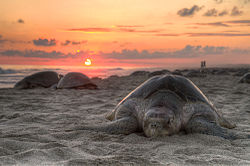After learning that an injured Olive Ridley turtle (no right foreleg) had been found at Juhu Chowpatty and local people were trying to set it back in the water, Mumbai police brought the turtle back to the police station. They took help from Eco-Echo NGO and entrusted the turtle to the Bombay SPCA (Society for the Prevention of Cruelty to Animals).
The turtle is in good health, but because of the loss of a flipper, if we were to release it back into its natural habitat, its survival rate would be less than 20 per cent.
A regular occurrence:
On an average, approximately 10 Olive Ridleys are found injured every year in Mumbai. Injuries mainly happen during the monsoon season. Trawlers used for fishing in the Uttan-Gorai coastal belt pose a danger. Their nets and propellers are dangerous for the animals.
About Olive Ridley turtles
- The Olive ridley turtles are the smallest and most abundant of all sea turtles found in the world, inhabiting warm waters of the Pacific, Atlantic and Indian oceans
- This species is recognized as Vulnerable by the IUCN Red list.
- Olive ridley gets its name from its olive colored carapace, which is heart-shaped and rounded.
- These turtles spend their entire lives in the ocean, and migrate thousands of kilometers between feeding and mating grounds in the course of a year.
- Interestingly, females return to the very same beach from where they first hatched, to lay their eggs
- They generally nest their eggs at Rushikulya rookery coast in Ganjam district of Odisha
- Apart from coasts of Orissa, these turtles also visit the coasts of Mexico and Costa Rica for nesting
- They reach the sandy beach in the darkness of night, dug out holes with their flippers, lay eggs in the holes in sand and cover them up, before returning back to sea.
- The eggs will incubate for around 45 days on their own due to heat of the sand.
Protection measures
- Before the mass nesting season at a coast, a few mother turtles come to nest much earlier to assess the condition of the coast line.
- Forest department has imposed restrictions on entry of visitors and tourists to over three kilometre stretch of beach.
- This whole stretch has been divided into 45 segments by the forest department based on records of data regarding nesting. Tourists as well as local visitors are being allowed entry only in two segments so that human crowd does not affect the mass nesting process.
- WWF(World wildlife fund)-India, along with the fishermen community, has been involved in protecting the Olive ridley rookery at the mass nesting site at Rushikulaya, in Orissa, by fencing off the nesting area and patrolling it till hatching and ensuring a safe passage for the hatchlings to the sea.
- To reduce accidental killing in India, the Orissa government has made it mandatory for trawls to use Turtle Excluder Devices (TEDs), a net specially designed with an exit cover which allows the turtles to escape while retaining the catch





